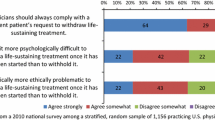Abstract
An individual’s right to refuse life-sustaining treatment is a fundamental expression of patient autonomy; however, supporting this right poses ethical dilemmas for healthcare providers when the patient has attempted suicide. Emergency physicians encounter patients who have attempted suicide and are likely among the first medical providers to face the dilemma of honoring the patient’s DNR or intervening to reverse the effects of potentially fatal actions. We illustrate this issue by introducing a case example in which the DNR of a terminally ill woman was not honored because the cause of her cardiac arrest was suicide. We argue that although a terminal diagnosis should change the way health care providers respond to a suicide attempt, many of the theoretical underpinnings for how one should treat suicide attempts—especially the criterion of external reasonability, that is the action to withhold or withdraw life-sustaining measures is reasonable independent of the precipitating event—are common to all situations (Brown et al. in Am J Bioeth 13(3):3–12, 2013). The presumption that patients who attempt suicide lack capacity due to acute mental illness is flawed because it fails to account for a competent individual’s reasonable preference to not be forced to live in an unbearable, terminal condition. In states without legislation allowing physician aid in dying, patients and providers must grapple with these limitations on a case-by-case basis. In cases where the patient has a limited life expectancy and there is not concern for psychiatric illness as the primary cause of the suicidal action, we argue that the negative right to refuse life-sustaining treatment should prevail.
Similar content being viewed by others
References
Braun, U. K., Beyth, R. J., Ford, M. E., et al. (2007). Defining limits in care of terminally ill patients. British Medical Journal, 334, 239–241.
Brown, S. M., Elliott, C. G., & Paine, R. (2013). Withdrawal of non-futile life support after attempted suicide. American Journal of Bioethics, 13(3), 3–12.
Crowley, C. (2011). Life interrupts an attempt to die at home. Albany, NY: Times Union.
Geppert C. (2011). Saving life or respecting autonomy: The ethical dilemma of DNR orders in patients who attempt suicide. The Internet Journal of Law, Healthcare and Ethics, 7(1). http://ispub.com/IJLHE/7/1/11437.
Gunderson, M., & Mayo, D. J. (2000). Restricting physician-assisted death to the terminally ill. Hastings Center Report, 30(6), 17–23.
Kass-Bartelmes, B. L., & Hughes, R. (2003). Advance care planning: Preferences for care at the end of life. Research in Action, 12, 1–20.
Krischer, J. P., Fine, E. G., Davis, J. H., et al. (1987). Complications of cardiac resuscitation. Chest, 92, 287–291.
Librach, S. L. (1995). Special issues in pain control during terminal illness. Canadian Family Physician, 41, 415–419.
Lizza, J. P. (2007). Potentiality and human embryos. Bioethics, 21(7), 379–385.
Mercadante, S. (2014). Managing difficult pain conditions in the cancer patient. Current Pain and Headache Reports, 18 (2), 395.
Pessin, H., Rosenfeld, B., & Breitbart, W. (2002). Assessing psychological distress near the end of life. American Behavioral Scientist, 46(3), 357–372.
Rachels, J. (1975). Active and passive euthanasia. The New England Journal of Medicine, 1975(292), 78–80.
Rosenfeld, B., Pessin, H., Marziliana, A., et al. (2014). Does desire for hastened death change in terminally ill cancer pateints? Social Science and Medicine, 111, 35–40.
Sine, D. M. (2010). EMS, suicide, and the out-of-hospital DNR order. The Online Journal of Health Ethics, 6(1), 1–13.
Author information
Authors and Affiliations
Corresponding author
Rights and permissions
About this article
Cite this article
Campo-Engelstein, L., Jankowski, J. & Mullen, M. Should Health Care Providers Uphold the DNR of a Terminally Ill Patient Who Attempts Suicide?. HEC Forum 28, 169–174 (2016). https://doi.org/10.1007/s10730-015-9289-1
Published:
Issue Date:
DOI: https://doi.org/10.1007/s10730-015-9289-1




